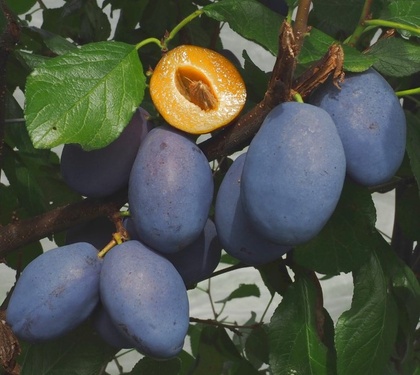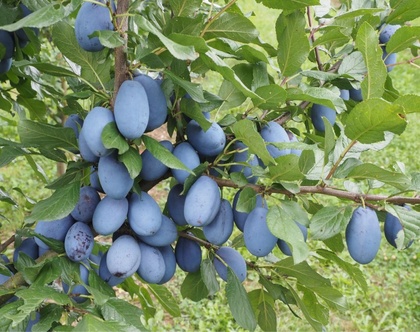Your success is our breeding aim
‘Moni®’ is a productive, Sharka resistant plum variety ripening in August after ‘Cacaks Schöne’ in the range of ‘Topfive’ und ‘Toptaste’. The fruit flesh is orange to amber and firm. The fruits are of outstanding high inner quality. The soluble solid content is rising even before the maturity stage. The time window for picking is very large as the fruits can be left on the tree very long. Therefore, the new variety covers a broad ripening time, starting with ‘Topfive’ and ending with ‘Toptaste’. Regular and high yields are typical of ‘Moni®’ variety and contribute to its good economy. This is a big advantage over the ‘Topfive’ variety which brings too low yield in many orchards. Compared to ‘Toptaste’ (= ‘Kulinaria®’), the new variety has three major advantages: free stone, Sharka resistance and no tendency to shrivel near the stalk.

The medium sized fruits (36-40 g) show a diameter between 35-38 mm. They are oval to elliptic and blue to dark blue with distinct wax bloom. The stalk is of medium length, moderately thick and separates easily from the fruit flesh. The fruit skin is smooth and not russeted.

The fruit flesh is firm to very firm. The soluble solid content varies between 19 und 27 Brix depending on the ripening stage of the fruits. The fruits taste distinctively sweet and have an acid content between 5.5 und 9 g/l. They are highly aromatic. This makes them extraordinarily well tasting which justifies the attribute „gourmet plum“. The fruits store well. The fruit flesh is very attractice due to its orange to amber colour. The stone is completely free and does not adhere to the fruit flesh. Until now, neither caverns nor gummosis (pectin residues in the fruit flesh) have been observed. On young trees, sometimes broken stones are found especially when induced by dry conditions during fruit development. On older trees, this is no longer the case. The fruits are very resistant to heat stress.

Moderate vegetative growth, branches easily. Rejuvenation of the fruiting wood should start at least in the fourth season. Very well suited for any kind of hedge training systems.
The variety is resistant to the Plum pox virus (PPV) due to the hypersensitivity resistance. That means that trees of this variety do not get diseased in the orchard. The use of rootstocks with hypersensitivity resistance (‘Docera® 6’ oder ‘Dospina® 235’) is essential.
Flowering time is early to medium. So far, ‘Haroma’ and ‘Cacaks Schöne’ are recommended as pollinators. Completing studies on self-fertility and further pollinators are under way.
The foliage can turn yellowish in early summer. This is a varietal characteristic and does not affect growth or yield. In midsummer the foliage turns deep green again.

The Obstgroßmarkt Mittelbaden (OGM, Oberkirch) and the Vereinigten Großmärkte für Obst und Gemüse Rheinhessen (VOG, Ingelheim) fund the plum breeding programme at the Bavarian Centre of Pomology and Fruit Breeding. Their members will be granted a reduction of the licence fees.
The Bavarian Centre of Pomology and Fruit Breeding runs the worlds largest breeding programme for European plum (Prunus domestica). We are breeding for varieties which are best suited for present and future market conditions and consumer preferences. This progress will constitute a quantum leap in fruit quality of European plum fruits.
The fruits of the new generation of plum varieties should be tolerant to cracking and to Monilinia fruit rot, good shelf life, without endocarp splitting (caverns), without tendency to stone cracking, with completely free stone and the fruits must be suited for fresh consumption as well as for processing including bakery. However, excellent taste is of utmost importance. Selling fruits with perfect taste is the only way how to increase European plum consumption in the future. Indeed, consumer tests with the new plum varieties have shown that the repurchase rate is unexpectedly high.
Thus, fruits of those European plums can easily compete with peaches, apricots and Japanese plums. The availability of the new generation of plum varieties and therefore of regionally produced, tasteful and healthy food is a chance for the fruit growers and the consumers. Take your chance!
‘Moni®’ is one of the first varieties of this new generation of European plum varieties. It was bred by Dr. Michael Neumüller at Technical University of Munich and at Bavarian Centre of Pomology and Fruit Breeding.